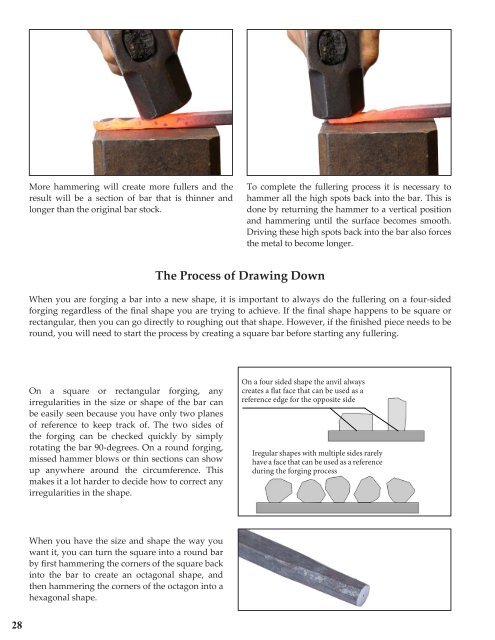The New Spruce Forge Manual of Locksmithing: A Blacksmith’s Guide to Simple Lock Mechanisms
The New Spruce Forge Manual of Locksmithing: a Blacksmith’s Guide to Simple Lock Mechanisms is a totally revised and expanded version of the original work from 1999. This new hardcover edition, at 304 pages and with more than 800 color photos and illustrations, is more than double the size of the original manual. It is divided into two distinct sections: Technical Information - This section is a reference manual in itself that covers the specific tools and techniques needed to build all the parts for each lock, as well as providing the information needed to understand the assembly instructions outlined in the second section. The Locks: Patterns & Instructions - This section provides the plans and detailed instructions for each of the 14 lock projects in this new edition. The clear assembly instructions describe when and how to use the technical information provided in section one. The authors have maintained their original trademark style that relies on well-illustrated step-by-step instructions that guide you through the whole lock-making process. They have also kept their low-tech approach that demonstrates how to go about creating good work using only a handful of simple tools. Making blacksmith locks is an age-old skill the authors of this manual are helping to preserve by passing on their knowledge to this book’s readers. The New Spruce Forge Manual of Locksmithing is also an excellent introduction to benchwork, which is a useful skill for any blacksmith to acquire. This manual will become a valuable, trusted and often referred to sourcebook in your blacksmithing library. Hardcover, 304 pages, more than 800 photos and illustrations.
The New Spruce Forge Manual of Locksmithing: a Blacksmith’s Guide to Simple Lock Mechanisms is a totally revised and expanded version of the original work from 1999. This new hardcover edition, at 304 pages and with more than 800 color photos and illustrations, is more than double the size of the original manual.
It is divided into two distinct sections:
Technical Information - This section is a reference manual in itself that covers the specific tools and techniques needed to build all the parts for each lock, as well as providing the information needed to understand the assembly instructions outlined in the second section.
The Locks: Patterns & Instructions - This section provides the plans and detailed instructions for each of the 14 lock projects in this new edition. The clear assembly instructions describe when and how to use the technical information provided in section one.
The authors have maintained their original trademark style that relies on well-illustrated step-by-step instructions that guide you through the whole lock-making process. They have also kept their low-tech approach that demonstrates how to go about creating good work using only a handful of simple tools.
Making blacksmith locks is an age-old skill the authors of this manual are helping to preserve by passing on their knowledge to this book’s readers. The New Spruce Forge Manual of Locksmithing is also an excellent introduction to benchwork, which is a useful skill for any blacksmith to acquire. This manual will become a valuable, trusted and often referred to sourcebook in your blacksmithing library.
Hardcover, 304 pages, more than 800 photos and illustrations.
You also want an ePaper? Increase the reach of your titles
YUMPU automatically turns print PDFs into web optimized ePapers that Google loves.
More hammering will create more fullers and the<br />
result will be a section <strong>of</strong> bar that is thinner and<br />
longer than the original bar s<strong>to</strong>ck.<br />
To complete the fullering process it is necessary <strong>to</strong><br />
hammer all the high spots back in<strong>to</strong> the bar. This is<br />
done by returning the hammer <strong>to</strong> a vertical position<br />
and hammering until the surface becomes smooth.<br />
Driving these high spots back in<strong>to</strong> the bar also forces<br />
the metal <strong>to</strong> become longer.<br />
<strong>The</strong> Process <strong>of</strong> Drawing Down<br />
When you are forging a bar in<strong>to</strong> a new shape, it is important <strong>to</strong> always do the fullering on a four-sided<br />
forging regardless <strong>of</strong> the final shape you are trying <strong>to</strong> achieve. If the final shape happens <strong>to</strong> be square or<br />
rectangular, then you can go directly <strong>to</strong> roughing out that shape. However, if the finished piece needs <strong>to</strong> be<br />
round, you will need <strong>to</strong> start the process by creating a square bar before starting any fullering.<br />
On a square or rectangular forging, any<br />
irregularities in the size or shape <strong>of</strong> the bar can<br />
be easily seen because you have only two planes<br />
<strong>of</strong> reference <strong>to</strong> keep track <strong>of</strong>. <strong>The</strong> two sides <strong>of</strong><br />
the forging can be checked quickly by simply<br />
rotating the bar 90-degrees. On a round forging,<br />
missed hammer blows or thin sections can show<br />
up anywhere around the circumference. This<br />
makes it a lot harder <strong>to</strong> decide how <strong>to</strong> correct any<br />
irregularities in the shape.<br />
On a four sided shape the anvil always<br />
creates a flat face that can be used as a<br />
reference edge for the opposite side<br />
Iregular shapes with multiple sides rarely<br />
have a face that can be used as a reference<br />
during the forging process<br />
When you have the size and shape the way you<br />
want it, you can turn the square in<strong>to</strong> a round bar<br />
by first hammering the corners <strong>of</strong> the square back<br />
in<strong>to</strong> the bar <strong>to</strong> create an octagonal shape, and<br />
then hammering the corners <strong>of</strong> the octagon in<strong>to</strong> a<br />
hexagonal shape.<br />
28










